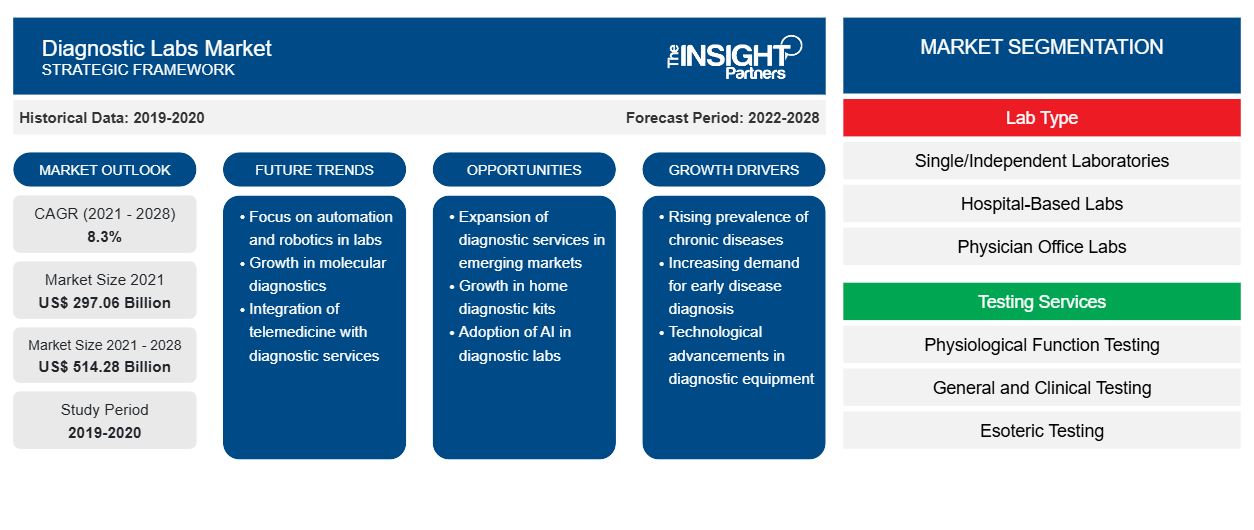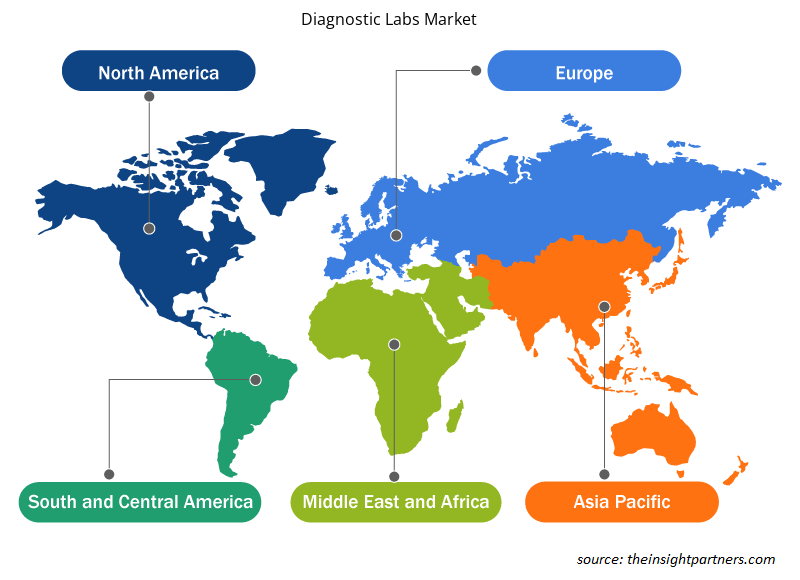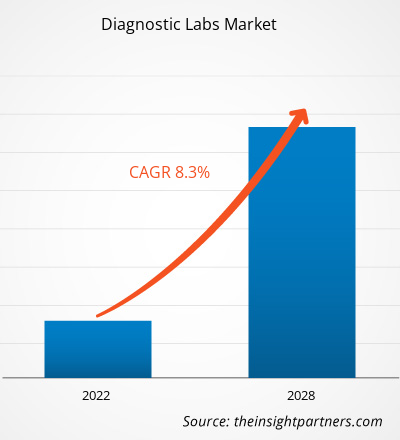[Research Report] The diagnostic labs market is projected to grow from US$ 297.06 billion in 2021 to US$ 514.28 billion by 2028; it is expected to grow at a CAGR of 8.3% from 2022 to 2028.
The increasing prevalence of chronic diseases, increasing use of point-of-care diagnostics, and rising healthcare expenditures bolster the growth of the diagnostic labs market. Additionally, the growing developments in diagnostics laboratories are likely to emerge as a significant future trend in the diagnostic labs market from 2022 to 2028. However, a shortage of skilled professionals hampers the overall market growth.
Consequently, the health-tech era took off and transformed the healthcare segment to unimaginable levels. Since then, various start-ups have emerged that have revolutionized the industry with innovations such as telemedicine, teleconsultation, and, in particular, diagnostic solutions. Diagnostics labs form the backbone of healthcare. Technology adoption is essential to meet the increasing consumer demand and have a competitive advantage in the market. In light of this, industry players are harnessing the power of technology to offer new generation healthcare solutions. The technology used in diagnostic labs is rapidly moving toward complete transformation with the help of the latest developments in artificial intelligence (AI) and machine learning (ML). From developing accurate and efficient diagnostic solutions to adapting to technological interventions, various forward-thinking R&D teams are already working to develop newer and simpler blood analysis and diagnosis methods. Some of the developments in the diagnostics lab market are as follows:
- In January 2019, Roche launched the Cobas pro integrated solutions in all countries accepting the CE mark. The product has reset maintenance, efficiency, and reliability standards by increasing patient satisfaction and lowering the cost of healthcare delivery.
- In February 2020, Ortho Clinical Diagnostics launched a clinical chemistry system that completed its integrated Vitros XT line, designed to cover most typical lab tests. The company estimated its maximum throughput at 755 tests per hour with single-test slides and 1,130 tests per hour with dual-test slides. Moreover, The company’s XT 3400 system received CE marking and is available in the US, Canada, Europe, India, Japan, and a few countries in the Middle East & Africa.
- In September 2021, Ortho Clinical Diagnostics announced the availability of Immediate Spin Crossmatch (ISXM) on the company's Ortho Vision and Ortho Vision Max analyzers to help identify recipient-donor incompatibilities in blood transfusions.
Therefore, such developments would boost the market for diagnostics labs shortly.
Customize This Report To Suit Your Requirement
You will get customization on any report - free of charge - including parts of this report, or country-level analysis, Excel Data pack, as well as avail great offers and discounts for start-ups & universities
Diagnostic Labs Market: Strategic Insights

- Get Top Key Market Trends of this report.This FREE sample will include data analysis, ranging from market trends to estimates and forecasts.
You will get customization on any report - free of charge - including parts of this report, or country-level analysis, Excel Data pack, as well as avail great offers and discounts for start-ups & universities
Diagnostic Labs Market: Strategic Insights

- Get Top Key Market Trends of this report.This FREE sample will include data analysis, ranging from market trends to estimates and forecasts.
North America is estimated to continue its dominance in the diagnostic labs market during 2022–2028. The region is anticipated to witness substantial demand for diagnostic labs over the forecast period, owing to the increasing adoption of technological advancements and rising research and development activities in this region. Improved healthcare infrastructure and appropriate reimbursement policies also support the North America diagnostic labs market. The US is expected to hold the largest market share in the North American market from 2022 to 2028. The market is expected to grow in the coming years owing to the increasing adoption of technological advancements and rising emphasis on improving treatment outcomes. The US diagnostic labs serve as the foundation for millions of patients' early diagnosis, prevention, and personalized care, accelerating demand at a large scale. For example, early diagnosis, prevention, and personalized care in diagnostic labs in the US involve routine blood tests of patients and ground-breaking genetic and molecular diagnostics. Diagnostic laboratories play a vital role in improving patient outcomes and quality of life delivery of better healthcare value to the healthcare system, according to the American Clinical Laboratory Association (ACLA) report. Additionally, diagnostic laboratory services comprise only 2.3% of US healthcare expenditure and 2% of medicare expenditure. Therefore, diagnostic laboratories are an integral part of the US healthcare system and the patient it services. Moreover, nearly 25% of US patient care quality indicators for adults are included in laboratory tests. Quality indicators are standardized, evidence-based measures of healthcare quality that can be used readily by hospitals serving inpatient administrative data for tracking and measuring clinical performance and outcomes. Such quality indicators play a vital role in ensuring high-quality, cost-effective clinical care by informing laboratory medicine professionals to obtain objective scientific data and deliver an interpretation of results of US adults. Such factors mentioned above are driving the growth of the diagnostic labs market.
Revenue Source Insights
Based on revenue source, the diagnostic labs market is segmented into healthcare plan operators and insurers, out-of-pocket, and public system. The healthcare plan operators and insurers segment is estimated to account for the largest market share during 2022–2028. There has been an increase in the number of private insurers that offer customizable insurance products. Many of the provisions provided by the Global Government are similar to the Affordable Care Act, which focuses on expanding healthcare insurance coverage. It generates incentives for employers to provide health coverage and compels people who are not covered under the insurance program of their governments or employers to purchase private healthcare insurance. In 2018, ~23% of Global had private medical/hospital insurance, and ~9.6% had dental insurance. Moreover, ~70% of beneficiaries, who receive health insurance facilities, receive their private health insurance as an employment benefit. Private health plan operators offer healthcare services through facilities or accredited healthcare organizations. Alternatively, they can reimburse enrollees for purchased health care services. The aforementioned factors will help boost the healthcare plan operators and insurers segment in the forecast period.
Companies operating in the diagnostic labs market adopt the product innovation strategy to meet the evolving customer demands worldwide, allowing them to maintain their brand name in the global diagnostic labs market.
Diagnostic Labs Market Regional Insights
The regional trends and factors influencing the Diagnostic Labs Market throughout the forecast period have been thoroughly explained by the analysts at Insight Partners. This section also discusses Diagnostic Labs Market segments and geography across North America, Europe, Asia Pacific, Middle East and Africa, and South and Central America.

- Get the Regional Specific Data for Diagnostic Labs Market
Diagnostic Labs Market Report Scope
| Report Attribute | Details |
|---|---|
| Market size in 2021 | US$ 297.06 Billion |
| Market Size by 2028 | US$ 514.28 Billion |
| Global CAGR (2021 - 2028) | 8.3% |
| Historical Data | 2019-2020 |
| Forecast period | 2022-2028 |
| Segments Covered |
By Lab Type
|
| Regions and Countries Covered | North America
|
| Market leaders and key company profiles |
Diagnostic Labs Market Players Density: Understanding Its Impact on Business Dynamics
The Diagnostic Labs Market is growing rapidly, driven by increasing end-user demand due to factors such as evolving consumer preferences, technological advancements, and greater awareness of the product's benefits. As demand rises, businesses are expanding their offerings, innovating to meet consumer needs, and capitalizing on emerging trends, which further fuels market growth.
Market players density refers to the distribution of firms or companies operating within a particular market or industry. It indicates how many competitors (market players) are present in a given market space relative to its size or total market value.
Major Companies operating in the Diagnostic Labs Market are:
- Quest Diagnostics Incorporated
- Eurofins Scientific
- Laboratory Corporation of America Holdings
- Exact Sciences Laboratories LLC
- SYNLAB International GmbH
Disclaimer: The companies listed above are not ranked in any particular order.

- Get the Diagnostic Labs Market top key players overview
Diagnostic Labs Market – Segmentation
Based on lab type, the diagnostic labs market is segmented into single/independent laboratories, hospital-based labs, physician office labs, and others. Based on testing services, the diagnostic labs market is segmented into physiological function testing, general and clinical testing, esoteric testing, specialized testing, non-invasive prenatal testing, COVID-19 testing, and others. By revenue source, the diagnostic labs market is segmented into healthcare plan operators and insurers, out-of-pocket, and public system. Based on geography, the diagnostic labs market is primarily segmented into North America, Europe, Asia Pacific, Middle East & Africa (MEA), and South & Central America. The market in North America is further segmented into the US, Canada, and Mexico. The European diagnostic labs market is subsegmented into France, Germany, the UK, Spain, Italy, and the Rest of Europe. The market in Asia Pacific is subsegmented into China, India, Japan, Australia, South Korea, and the Rest of Asia Pacific. The diagnostic labs market in the MEA is further segmented into Saudi Arabia, the UAE, South Africa, and the Rest of the MEA. The diagnostic labs market in South & Central America is segmented into Brazil, Argentina, and the Rest of South & Central America.
Company Profiles
- Quest Diagnostics Incorporated
- Eurofins Scientific
- Laboratory Corporation of America Holdings
- Exact Sciences Laboratories LLC
- SYNLAB International GmbH
- Sonic Healthcare Limited
- DASA Labs
- Kingmed Diagnostics
- Healius Limited
- BioReference
Frequently Asked Questions
What is meant by the diagnostic labs market?
Answer: Diagnostic laboratories play an important role in reducing the widespread impact of certain diseases. The experts in the pathology labs are skilled enough to get into the details of the underlying problems. As diagnostic chains and insurance coverage expand, clinical laboratory tests are becoming more common. This is due to the increasing demands for the early detection of diseases and the earliest possible search for causes to receive appropriate therapy. Due to an increased burden of COVID-19 testing or a drop in demand for other types of diagnostic tests, several laboratories have stopped performing other diagnostic procedures. During the first wave of COVID-19, diagnostic labs were forced to offer at-home sample collection services as the number of cases and people coming into the labs increased.
Which segment led the diagnostic labs market?
Based on lab type, hospital-based labs took the forefront leaders in the worldwide market by accounting largest share in 2022 and is expected to continue to do so till the forecast period.
What are the driving factors for the diagnostic labs market across the globe?
Increasing prevalence of chronic diseases and increasing use of point-of-care diagnostics is one of the most significant factors responsible for the overall market growth.
Which testing services segment held the largest revenue (US$ Mn) in the diagnostic labs market?
The physiological function testing segment dominated the global diagnostic labs market and accounted for the largest revenue of US $94.66 million in 2022.
What is the regional market scenario of the diagnostic labs market?
Global diagnostic labs market is segmented by region into North America, Europe, Asia Pacific, Middle East & Africa, and South & Central America. In North America, the U.S. is the largest market for diagnostic labs market. The US is estimated to hold the largest share in the diagnostic labs market during the forecast period. The presence of top players and favorable regulations related to product approvals coupled with commercializing new products are the contributing factors for the regional growth. Additionally, the increasing number of technological advancements is the key factor responsible for the Asia-Pacific regional growth for diagnostic labs accounting fastest growth of the region during the coming years.
Who are the key players in the diagnostic labs market?
Quest Diagnostics Incorporated; Eurofins Scientific; Laboratory Corporation of America Holdings; Exact Sciences Laboratories LLC; SYNLAB International GmbH; Dasa Labs; KingMed Diagnostics; BioReference; Sonic Healthcare Limited; Healius Limited are among the leading companies operating in the global diagnostic labs market
- Historical Analysis (2 Years), Base Year, Forecast (7 Years) with CAGR
- PEST and SWOT Analysis
- Market Size Value / Volume - Global, Regional, Country
- Industry and Competitive Landscape
- Excel Dataset
Testimonials
I wish to appreciate your support and the professionalism you displayed in the course of attending to my request for information regarding to infectious disease IVD market in Nigeria. I appreciate your patience, your guidance, and the fact that you were willing to offer a discount, which eventually made it possible for us to close a deal. I look forward to engaging The Insight Partners in the future, all thanks to the impression you have created in me as a result of this first encounter.
DR CHIJIOKE ONYIA, MANAGING DIRECTOR, PineCrest Healthcare Ltd.The Insight Partners delivered insightful, well-structured market research with strong domain expertise. Their team was professional and responsive throughout. The user-friendly website made accessing industry reports seamless. We highly recommend them for reliable, high-quality research services
Yukihiko Adachi CEO, Deep Blue, LLC.Reason to Buy
- Informed Decision-Making
- Understanding Market Dynamics
- Competitive Analysis
- Customer Insights
- Market Forecasts
- Risk Mitigation
- Strategic Planning
- Investment Justification
- Identifying Emerging Markets
- Enhancing Marketing Strategies
- Boosting Operational Efficiency
- Tracking Industry Innovations
- Aligning with Regulatory Trends
Yes! We provide a free sample of the report, which includes Report Scope (Table of Contents), report structure, and selected insights to help you assess the value of the full report. Please click on the "Download Sample" button or contact us to receive your copy.
Absolutely — analyst assistance is part of the package. You can connect with our analyst post-purchase to clarify report insights, methodology or discuss how the findings apply to your business needs.
Once your order is successfully placed, you will receive a confirmation email along with your invoice.
• For published reports: You’ll receive access to the report within 4–6 working hours via a secured email sent to your email.
• For upcoming reports: Your order will be recorded as a pre-booking. Our team will share the estimated release date and keep you informed of any updates. As soon as the report is published, it will be delivered to your registered email.
We offer customization options to align the report with your specific objectives. Whether you need deeper insights into a particular region, industry segment, competitor analysis, or data cut, our research team can tailor the report accordingly. Please share your requirements with us, and we’ll be happy to provide a customized proposal or scope.
The report is available in either PDF format or as an Excel dataset, depending on the license you choose.
The PDF version provides the full analysis and visuals in a ready-to-read format. The Excel dataset includes all underlying data tables for easy manipulation and further analysis.
Please review the license options at checkout or contact us to confirm which formats are included with your purchase.
Our payment process is fully secure and PCI-DSS compliant.
We use trusted and encrypted payment gateways to ensure that all transactions are protected with industry-standard SSL encryption. Your payment details are never stored on our servers and are handled securely by certified third-party processors.
You can make your purchase with confidence, knowing your personal and financial information is safe with us.
Yes, we do offer special pricing for bulk purchases.
If you're interested in purchasing multiple reports, we’re happy to provide a customized bundle offer or volume-based discount tailored to your needs. Please contact our sales team with the list of reports you’re considering, and we’ll share a personalized quote.
Yes, absolutely.
Our team is available to help you make an informed decision. Whether you have questions about the report’s scope, methodology, customization options, or which license suits you best, we’re here to assist. Please reach out to us at sales@theinsightpartners.com, and one of our representatives will get in touch promptly.
Yes, a billing invoice will be automatically generated and sent to your registered email upon successful completion of your purchase.
If you need the invoice in a specific format or require additional details (such as company name, GST, or VAT information), feel free to contact us, and we’ll be happy to assist.
Yes, certainly.
If you encounter any difficulties accessing or receiving your report, our support team is ready to assist you. Simply reach out to us via email or live chat with your order information, and we’ll ensure the issue is resolved quickly so you can access your report without interruption.















The List of Companies - Diagnostic Labs Market
- Quest Diagnostics Incorporated
- Eurofins Scientific
- Laboratory Corporation of America Holdings
- Exact Sciences Laboratories LLC
- SYNLAB International GmbH
- Sonic Healthcare Limited
- DASA Labs
- Kingmed Diagnostics
- Healius Limited
- BioReference.






 Get Free Sample For
Get Free Sample For